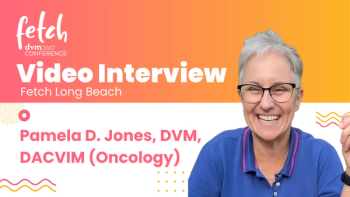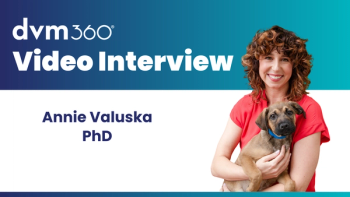
Rethinking pain: Q&A with Richard Goldstein, DVM, DACVIM (SAIM), DECVIM-CA on preventive OA management
Goldstein calls for a shift in veterinary practice from reactive pain treatment to proactive osteoarthritis prevention and lifelong wellness, as National Pet Wellness Month comes to a close.
Richard Goldstein, DVM, DACVIM (SAIM), DECVIM-CA, is internationally recognized for his expertise in companion animal medicine. He currently serves as global chief medical officer at Zoetis. Before joining Zoetis, Goldstein was chief medical officer at the Stephen & Christine Schwarzman Animal Medical Center in New York, New York, the largest nonprofit animal hospital globally. He previously served as an associate professor of internal medicine at Cornell University College of Veterinary Medicine in Ithaca, New York, where his work focused on infectious, renal, and genetic diseases.
This interview has been edited and condensed for clarity.
dvm360: National Pet Wellness Month emphasizes prevention. How does osteoarthritis (OA) fit into the larger preventative care conversation for cats and dogs, especially considering many cases go undiagnosed until later stages?
Goldstein: That’s a really important question and important concept. Osteoarthritis is a disease that starts in young dogs. It starts subtly. It’s a disease that causes abnormal inflammation in the joint that then causes pain, and all of those things start young. Often, pet owners don’t pick up on it until dogs are older because they don’t pick up on it until it’s quite severe.
We can even expand prevention conversations to wellness discussions. Prevention is part of an overall wellness program, and it includes seeing dogs and cats on a schedule, starting when they’re puppies and kittens, even if there is nothing apparently wrong with them.
And then we prevent the things that we can from happening using vaccines and parasiticides, but we also try to do early detection. We try to pick up things early before there are clinical signs by doing physical exams and blood work. Maybe take x-rays if OA is suspected, and then we can start treating early. There are huge advantages to starting treatment early. So, I would say prevention is wonderful. Wellness as an overall package is even better, and that includes prevention and early detection, and treatment.
dvm360: What are some of the most common barriers veterinarians face in identifying osteoarthritis early clinically and in communicating with clients about subtle signs of pain?
Goldstein: I think part of it is just that mindset of wellness and prevention. I think pet owners—and many veterinarians—are still used to a if it’s not broken, don’t fix it kind of mentality, which means wait until it’s really late—until the dog and cat are showing obvious signs, and then bring them to the vet. We need to change our mindset to a wellness-first one.
There is also a lot of education that needs to happen, both for veterinarians and for pet owners, on how to detect osteoarthritis early. Dogs and cats are very good at hiding their clinical signs. They’re a lot closer to the wild than we are, so they’re not going to show [many] subtle signs. [When we feel pain,] we [might prefer] to take something for it. We don't want to be at that level of pain.
But dogs and cats still appear to be normal—they’ll chase a ball and catch a Frisbee despite being in pain. So, it's important to educate pet owners on what the early signs of pain are. Don’t wait until they can’t go up the stairs. Look at how they get up. Look at how they’re sitting. Look at how they’re lying down. Look at how long it takes them to get up in the morning. Make videos of your dog when they’re normal, when they’re young and healthy, and then see how that progresses.
For cats, we have a feline OA checklist that shows people things that you can look for to diagnose OA early. Those kinds of tools are really important.
It's important even for the veterinarian. Many veterinarians didn’t learn about this in vet school. Pain was often not a huge subject, even though part of our role as veterinarians and the oath we take is to manage pain.
So, education should come first. We should also have the awareness that pain is a disease. We don’t want dogs to be in pain, even if it appears subtle; it’s probably not subtle to them.
We have therapies today that can alleviate that pain in an easy, convenient, persistent way. I think that [conversations on] pain should be part of the discussion that clients have with a new puppy or kitten, just like nutrition, spay/neuter, and vaccines.
Let’s talk about your dog’s or cat’s mobility. Look at how they can run around and wiggle today. Let’s make sure that they have that level of comfort for as long as they possibly can in their life. If there is any change at all, let’s jump on it early and treat it.
dvm360: How common is osteoarthritis?
Goldstein: The number we have is 40%—it may be even higher for dogs because a lot of it goes undiagnosed. It is one of the most common and undiagnosed problems because people think their dogs are just getting older, and they don’t bring them to the vet. By the time they’re 8 or 9 or 10, other issues need to be addressed as well. They might have metabolic diseases or other diseases, and then osteoarthritis kind of takes a backseat because there are more pressing issues. Really, the timeframe to diagnose osteoarthritis is when pets are young and when the disease is relatively less clinical, and then jump on it early and try to prevent that pain from getting worse down the road before the patient potentially develops other conditions as they age.
dvm360: Over the past few years, how have advances in pain management, including monoclonal antibodies, changed the way veterinarians approach OA earlier and more effectively?
Goldstein: Monoclonal antibodies have changed a lot of things. They’ve changed how we treat dermatologic disease and now they’re changing how we treat pain. Traditionally, in veterinary medicine, again, there was this mindset of “if it’s not severe, I’m not going to worry about it.” Back in the day, when I was in vet school, many veterinarians didn’t believe that pain was a thing. Luckily, we’ve gone past that.
However, today, many veterinarians still treat pain as needed. There’s this concept of if they’re having a bad day, give them a nonsteroidal anti-inflammatory (NSAID). Because of concerns about chronic NSAID use and the inconvenience of daily dosing—once or twice a day—these medications are often given only [when symptoms flare up]. In essence, we’re telling owners, “Your dog will have good days and bad days. When they have a bad day, give them something." What we should be saying is, “We don’t want your dog to have good days and bad days. We want every day to be a good day.”
So, let’s make sure we have something on board that will alleviate pain chronically, even in the days where it’s not as obvious, because the things that are causing pain—the abnormalities in the joints—they’re there all the time. The pain is there all the time. Even if pets don’t display pain consistently, the underlying discomfort remains constant. Let’s make sure they’re not in pain at all.
Monoclonal antibodies are canine-specific antibodies and function like the body’s own antibodies, which makes them very safe. They’re given once a month chronically, and they provide persistent, constant pain relief, without the ups and downs of “I’m going to give a pill or not give a pill.” It’s game-changing for how we can treat pain starting early on and then persistently for the life of the dog or cat or as long as they’re in pain. Again, our oath is—and I think every pet owner would agree—we don’t want them to be in pain at all.
dvm360: Beyond new therapies, what other developments in preventive medicine or technology excite you the most about the future of maintaining long-term mobility and comfort in pets?
Goldstein: It’s definitely an exciting area. It’s a great question because it’s an area I am and all of us are very passionate about. [The future of preventive medicine is about] helping drive that transition into preventive medicine and wellness, which will provide longer, healthier, happier lives with a better quality of life for our patients.
Quality of life is really the key goal. Conversations around giving veterinarians better tools for earlier diagnosis and disease prevention support the mission of helping pets live longer, happier lives. It’s about shifting the mindset—educating veterinarians and pet owners, and providing the right tools, like the ability to watch videos and ensure that these animals are maintaining the same mobility they had as puppies and kittens.
It’s also about education: knowing what to do once you start noticing subtle signs. For example, if you’re palpating a joint and it feels a little uncomfortable, take an x-ray—and then help the pet owner understand the value of that step. You’re often asking them to invest in an x-ray for a dog that seems relatively healthy, so explaining the “why” behind it is key. When we diagnose osteoarthritis early and start managing it, we not only relieve pain now, but also prevent it from worsening down the road.
That’s what excites me most about where we’re headed: having the right tools and continuing to shift the profession toward a wellness-first, prevention-driven mindset rather than a “call me if there’s a problem” approach.
Newsletter
From exam room tips to practice management insights, get trusted veterinary news delivered straight to your inbox—subscribe to dvm360.






